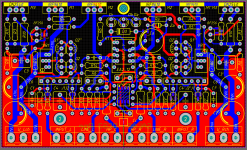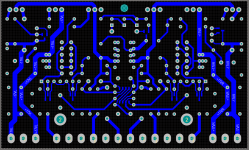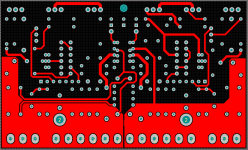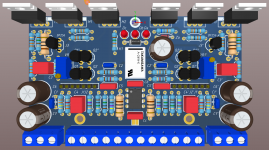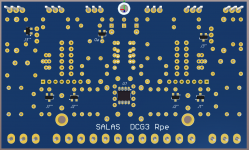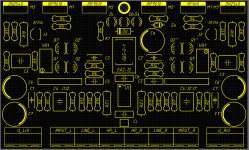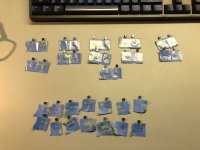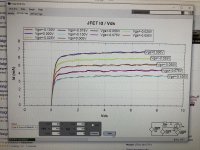Since you are making a board you have the freedom to put a Toshiba 2SK209-GR(TE85L,F) surface mount for J3. Watch the pinout and use 1R R3. You can use this SMD as J1 J2 to substitute any suspect uPA68H as well. The 2SK209s usually come close for IDSS right out of their packaging. Keep R1 & R6 physically close enough to their gate pins. For through hole uPA68H or BF256B genuine & sorted out for IDSS, as well as for Vgs matched DN2540 M3s ask Tea Bag for help. He has a stash of proper active parts.
I'm already close to the final version.🙂
Attachments
With premium headphones beyond better construction quality we usually get a wider stage, more detail, more sub bass. If you got all those over the Sundara you chose wisely on the Ananda. Law of diminishing returns regarding price and value is always there though.
I'm up for the choice "justification" if the side by side comparison option presents in the future. Agree on the law of diminishing returns.
I have started the previous post with intention to highlight how good DCG3 fleshes out and scales with these headphones, but ended up the describing the subjectivities involved. The soundstage, the timbre, details (resolution) are beyond comparison with and without EQ. With EQ, I don't miss the dynamic headphones punch and slam as advertised by reviewers up to this point.
If I were to cook a second unit, the main differences can be made with a diffferent PSU, pot and opamp choice, correct? Bias maybe?
I also have a turn on/off thump, so I guess I should try a 22nF 630V cap on the switch.
Yes, different PSUs and other details choices are more evident on high resolution headphones. 150mA output stage bias can be bit better on lower than 80 Ohm cans as well.
Tangential, but related: I've been thinking of building a new HPA from my own circuit and I was surprised to see that the published DN2540 curves don't match very well with the actual devices I have on hand. The bias current is much higher than would be expected for a given Vgs drop across the source resistor.
Also, as a follow-up to my previous post about the DCA75, I wrote to Peak Electronics and got a nice email back from the engineering director. He did offer to pay postage for me to send the suspect transistors in case a firmware update is needed. He also gave me some tips how to do measurements even when the DCA75 cannot identify the device.
On further investigation, it looks like I've got three blown TO220 DN2540s, one blown TO92 DN2540, and one blown IRF9610. The third TO220 went bad yesterday. I have no idea how the heck that happened, but I guess I need to get a lot more careful about my ESD protocol. The bad devices measure about 10K gate-to-drain while the good ones show open circuit in both directions.
I don't recall ever destroying a MOSFET or CMOS chip before, but it looks like it's trivially easy to do. So take care handling your transistors, especially in dry weather.
-Henry
Also, as a follow-up to my previous post about the DCA75, I wrote to Peak Electronics and got a nice email back from the engineering director. He did offer to pay postage for me to send the suspect transistors in case a firmware update is needed. He also gave me some tips how to do measurements even when the DCA75 cannot identify the device.
On further investigation, it looks like I've got three blown TO220 DN2540s, one blown TO92 DN2540, and one blown IRF9610. The third TO220 went bad yesterday. I have no idea how the heck that happened, but I guess I need to get a lot more careful about my ESD protocol. The bad devices measure about 10K gate-to-drain while the good ones show open circuit in both directions.
I don't recall ever destroying a MOSFET or CMOS chip before, but it looks like it's trivially easy to do. So take care handling your transistors, especially in dry weather.
-Henry
In happier news, I've been enjoying playing with my DCA75 tonight. I have thirty-six genuine 2SK170s and I managed to find eleven very closely-matched pairs (less than 0.05mA Idss, some pairs basically spot-on). I could probably get two or three more pairs matched to within 5% or less, but I have enough "perfect" pairs for five stereo projects, so that will keep me busy for a while.
I think I'm going to build up another DCG3, just because I have the parts.
I think I'm going to build up another DCG3, just because I have the parts.
Attachments
Atlas is handy for small semis indeed. Let us know what will be discovered in the end with that weird identification issue on some of your D-MOS samples.
Yes... As I mentioned before, it looks like I destroyed a bunch of devices with static discharge. I don't see any fault with the DCA75. That leaves the mystery of why I'm blowing up transistors. It's been really dry here lately and though I have a Velleman anti-static mat on my workbench, I don't use a wrist strap. I need to be more careful.
Sometimes, when I enter my workshop and touch the metal sideboard where the computer is placed, I discharge into it, instantly sending the monitor into standby...
I got aware of those sensitive parts and tell myself, „just what you think you‘re doing, dave?“ [emoji6]
I got aware of those sensitive parts and tell myself, „just what you think you‘re doing, dave?“ [emoji6]
I'm already close to the final version.🙂
Nice work!
I wonder, why you don't go smd for all the to92 small signal transistors? 😉
How do you ground yourself in a house?
Don
Avoid synthetic material / floor / textiles (and wear cotton, wool etc., and shoes with leather soles are good).
Touch any (grounded) metal-surface oftentimes.
When you work with sensitive stuff, ground yourself and the work-surface...
Avoid synthetic material / floor / textiles (and wear cotton, wool etc., and shoes with leather soles are good).
Touch any (grounded) metal-surface oftentimes.
When you work with sensitive stuff, ground yourself and the work-surface...
Well, I guess that is really the question. In radio, we drove a stake in the ground and connected a copper strap to it. My wife is not going for that inside the house where I do my soldering and build work.😀
Don
How do you ground yourself in a house?
Don
But you have some plumbing or heatpipes around? use this.
Or (after you confirmed it's correct so you can't blame me) use the safety earth of your electrical grid...
A ground rod or water pipe connection will help if your ham antenna gets struck by lightning. But earth ground isn't really "ground" in a meaningful electrical sense. That's why proper radio antennas have ground radials buried in the soil around them. For ESD protection, what you're trying to to is create a local bubble of relatively equipotential surfaces, with no extreme electric fields generating voltage differences that can zap gate oxides.
Or something like that.
Or something like that.
Hello,
I borrowed a friend's DCG3 and it has become my favorite preamp so I am setting out to build one. I read through 250 pages of this thread, but then gave up, so I am hoping to get some feedback on a few questions I have.
I have some spare power supply boards already built and I figured I would use them instead of the DCSTB, but after reading Salas' following comment regarding the UBiB, I am not so sure this is a good idea:
"On the other hand the net tonal result may acquire more solemnity of manner than neutral."
I am still trying to decipher this comment, as it sounds somewhat like a Six Moons review, but I am wondering if I would be better off using the intended DCSTB supply over what I currently have spares of, which are two UBiBs or two of Mark Johnson's VRDN supplies. Any thoughts?
Also, can anyone summarize the difference in sound between the BC560C and the BC327-40?
And finally, when I built a beta UFSP, I put the transformers and UBiBs in a separate chassis and fed the regulated DC through a Speakon umbilical to the chassis that holds the phono boards. I don't seem to have any issues with this setup, but I see in this thread that most people who are running two chassis convert to DC in the external chassis and then feed regulators housed in the same chassis as the audio boards. Would I be running into trouble if I moved the regulated boards into the external chassis with the transformers?
Thanks in advance!
Alan
I borrowed a friend's DCG3 and it has become my favorite preamp so I am setting out to build one. I read through 250 pages of this thread, but then gave up, so I am hoping to get some feedback on a few questions I have.
I have some spare power supply boards already built and I figured I would use them instead of the DCSTB, but after reading Salas' following comment regarding the UBiB, I am not so sure this is a good idea:
"On the other hand the net tonal result may acquire more solemnity of manner than neutral."
I am still trying to decipher this comment, as it sounds somewhat like a Six Moons review, but I am wondering if I would be better off using the intended DCSTB supply over what I currently have spares of, which are two UBiBs or two of Mark Johnson's VRDN supplies. Any thoughts?
Also, can anyone summarize the difference in sound between the BC560C and the BC327-40?
And finally, when I built a beta UFSP, I put the transformers and UBiBs in a separate chassis and fed the regulated DC through a Speakon umbilical to the chassis that holds the phono boards. I don't seem to have any issues with this setup, but I see in this thread that most people who are running two chassis convert to DC in the external chassis and then feed regulators housed in the same chassis as the audio boards. Would I be running into trouble if I moved the regulated boards into the external chassis with the transformers?
Thanks in advance!
Alan
If you use reasonable components and take care in the build, you may end up with something that has a different flavor from the reference design, but my hunch is you'll still get a very good result. That's been my experience, anyway. Probably either of your supplies would work well. You could try them both in a breadboard before you do the final assembly, then report your findings.
I know Salas would prefer you to stick with the published design. That's the safest bet; it all depends on your experience and confidence level.
Personally I would keep the regulators close to the signal board. The DCG3 has 100uF capacitors on board, so some of the ground current returns locally. But it seems like a compromise to force line-level signal currents to flow through a power supply umbilical, if you can avoid it.
Edit: Thinking about it some more, what I just said was a little silly; with the right grounding in the chassis, you can minimize the negative impact of a remote power supply. But it will still be best to keep the regulator in the same box with the signal circuitry.
I know Salas would prefer you to stick with the published design. That's the safest bet; it all depends on your experience and confidence level.
Personally I would keep the regulators close to the signal board. The DCG3 has 100uF capacitors on board, so some of the ground current returns locally. But it seems like a compromise to force line-level signal currents to flow through a power supply umbilical, if you can avoid it.
Edit: Thinking about it some more, what I just said was a little silly; with the right grounding in the chassis, you can minimize the negative impact of a remote power supply. But it will still be best to keep the regulator in the same box with the signal circuitry.
Last edited:
- Home
- Source & Line
- Analog Line Level
- Salas DCG3 preamp (line & headphone)
